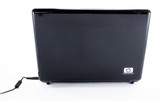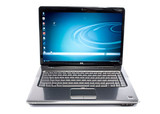HP Pavilion dv7-1070eg
Specifications

Price comparison
Average of 2 scores (from 2 reviews)
Reviews for the HP Pavilion dv7-1070eg
Source: Hardware Zone
 Archive.org version
Archive.org versionIf bigger is better, then the HP Pavilion dv7 is certainly that, given what we've seen and experienced during our hands-on testing of the unit. In fact, the size helps to seal the deal for the dv7; it's an entertainment unit and it's capable of some level of gaming but it actually manages to look and feel pretty thin and slim in spite of that. Given its ample real estate, HP has made good use of the space with a decent keyboard layout, with generous connectivity options that doesn't feel cluttered. If you're a fan of glossy reflective surfaces, then you'll love the shiny look of the current HP Pavilion series.
4.5 von 5
Single Review, online available, Medium, Date: 09/16/2008
Rating: Total score: 90%
Source: Laptop Mag
 Archive.org version
Archive.org versionThe HP Pavilion dv7 is the way to go for shoppers who want speed, lots of features, and a good-looking design. It trounces the Dell Studio 17 in both design and performance. The 16.4-inch Sony VAIO VGN-FW198U/H may be more portable, but it’s $200 more and lacks the dv7’s graphics muscle. If portability isn’t as big an issue, but multimedia is, you’ll be happy with this big-screen machine.
4 von 5, Leistung gut
Single Review, online available, Medium, Date: 07/14/2008
Rating: Total score: 80% performance: 80%
Comment
NVIDIA GeForce 9600M GT: Successor of the 8600M GT and because of the smaller 65nm production process the card is higher clocked (and therefore faster) with the same current consumption.Furthermore, it features an improved video processor (VP3) and HybridPower to save current (in conjunction with the 9100M G).
Non demanding games should be playable with these graphics cards.
» Further information can be found in our Comparison of Mobile Graphics Cards and the corresponding Benchmark List.
Intel Core 2 Duo: This is the Core Duo and Core Solo successor with a longer pipeline and 5-20% more speed without more power consumption. As an addition to the Core Duo design there exists a fourth decoder, an amplified SSE-unit and an additional arithmetical logical unit (ALU).
The Core 2 Duo for laptops is identical to the desktop Core 2 Duo processors but the notebook-processors work with lower voltages (0.95 to 1188 Volt) and a lower Frontside bus clock (1066 vs 667 MHz). The performance of equally clocked notebooks is 20-25% lower than Desktop PCs because of the lower Frontside bus clock and the slower hard disks.
T9400:
The T9400 is a fast middle class dual core CPU for laptops and basically a Core 2 Duo P9500 with a higher TDP of 35 Watt.
» Further information can be found in our Comparison of Mobile Processsors.














